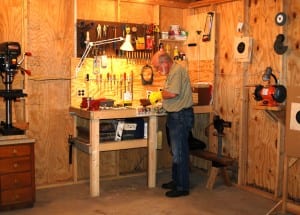 Your home shop doesn’t need to be huge. This small setup is more than adequate for most home gunsmithing tasks.
Your home shop doesn’t need to be huge. This small setup is more than adequate for most home gunsmithing tasks.
Bigger is definitely better with some things like steaks, chocolate cakes, and paychecks. Yeah, bigger can be a lot better. With that said, bigger is not necessarily better when it comes to a gunsmithing shop, and this is especially true if we’re talking about a home shop.
Over the years I’ve worked in a lot of different shops—some big, some small, some were great, and some were total disasters. I’ve had both good and bad experiences with a variety of different shop sizes and layouts. One important thing I’ve learned is the size of the shop has virtually no relationship to the quality of work produced in it.
Years ago I knew a fellow who was blessed with a very comfortable income. He wasn’t a millionaire, but he could afford just about anything he wanted. As a gunsmith hobbyist he had an absolutely fantastic shop, including
a beautiful new American-made lathe, a full-size South Bend mill, a couple of floor-mounted drill presses, a band saw, assorted buffers and grinders, and an incredible assortment of the finest hand tools. All of this first-class equipment was housed in a large, spacious building near his home. In short, he had it made! There was only one problem. No matter how hard he tried, and he really tried, he just couldn’t do good work.
Another friend had, and still has, a tiny, little shop. It’s nothing more than a small wood frame shed that couldn’t measure much more than about 12 feet by 16 feet. As I recall, the only pieces of power equipment he has are a very old, well-used floor-mounted drill press and a small grinder. That’s it. There are no other power tools. His hand tools are fairly limited, and almost all are quite old and well used. Even with all these limitations, he produces extremely fine work. With every gun he builds, each is better than the one before it. He’s one of the finest gunsmiths I know.
The bottom line is your shop need not be large or especially well equipped in order to be a darn nice place to work and develop your gunsmithing skills. While I now have a very well-equipped shop where I do my gunsmithing, I recently needed to set up a second shop.
My wife’s family has a little cabin up in northern Michigan. The whole family uses it over the summer, and it’s been the scene of many great times. As my wife and I get closer to retirement, we hope to spend more time up there. One of the things I need there is a place to work. Fortunately, there’s a storage shed on the property, and I’ve been given the go ahead to use one corner of the building as a gunsmithing shop.
Small Shop Must-Haves
Starting last fall, I began putting together my “northern” shop. Since space is limited as well as what I’ll be putting in it, it occurred to me there are lots of hobbyists facing similar challenges in setting up a shop. You may be living in an apartment, or you may just have a corner in the garage or some space in the attic or basement. No matter what your circumstances are, you can generally find a way to make your spot a suitable place to work.
 The small shop is centered around the bench. This one is made of 2x4s and plywood. The 2x4s are anchored to the wall studs for added support, and a 2-foot-high splash board is attached to the wall on the back and the right end of the bench.
The small shop is centered around the bench. This one is made of 2x4s and plywood. The 2x4s are anchored to the wall studs for added support, and a 2-foot-high splash board is attached to the wall on the back and the right end of the bench.
Before I get into the nuts and bolts of setting up the shop, there’s one place that can pose special challenges, and that’s the basement. If your basement is nice and dry, great! On the other hand, if you have a basement that’s damp or even floods occasionally, you have major problems. If you use a damp basement, you’ll be constantly fighting rust on your tools, equipment, and guns. In short, a damp basement shop can be a disaster. I’d much rather be in an unheated attic that’s too hot in the summer and too cold in the winter than in a wet basement. And yes, I’ve had shops in both locations!
Your shop will normally be centered around your bench. That’s were you’ll spend the majority of your time and where you’ll do most of your work. A suitable bench need not be large or built of super heavy materials. You can put together a very sturdy and durable bench using nothing more than standard 2x4s and a single piece of 3/8- or 1/2-inch plywood.
One of the secrets of building a sturdy bench is to place it in a corner and anchor it to the walls that form the corner. That’ll make your bench extremely rigid and stable.
Over the years I’ve found standard 2x4s work just fine for the frame and legs. Remember, you’re working on guns not aircraft engines. No need to overbuild and waste money on extra large planks. I generally make a simple rectangular frame of 2x4s 2 feet wide by 6 feet long. I then buy one sheet of 1/2-inch plywood and have the lumberyard cut it right down the center, giving me two 2×8-foot pieces. Later I’ll cut 2 feet off one piece and use the remaining 2×6-foot piece to form the top of my bench. You could make your bench any length and width, but I’ve found that 2×6 feet is just fine. If the bench gets much larger, it just becomes a collection site for junk. A clean, well-organized bench facilitates your work, and it’s generally a lot easier to control clutter on a smaller bench.
The leftover plywood can be used to make a splash board for the back of the bench if, like me, you have exposed studs in the wall. That’s also an ideal place to hang your files. Above that you can mount a piece of pegboard to hold all manner of tools and supplies.
The legs of your bench can be made by nailing two identical lengths of 2×4 together and then attaching them to the bench. Pay special attention to the height of your bench. You want it to be high enough so you don’t have to bend over as you work. That just leads to fatigue and back pain.
Keep the area under your bench clean and free of clutter. If you store things on the floor, it’ll just make locating dropped parts harder and provide a gathering place for dust and dirt. A simple shelf under the bench can hold your extra supplies. An inexpensive lockable toolbox on the bench is ideal for small hand tools, and it prevents them from being “borrowed.” Combine this with a modest sized vise mounted on the corner of the bench, and you’re in business.
A small shop does not have to be a liability. In fact, you can make the case that it’ll provide a great opportunity for inventiveness and creativity as you build it. You can have almost as much fun building your shop as you do working on your guns!
Until next time, good luck and good gunsmithing!
This article was originally posted by Reid Coffield, to view the original article click here



